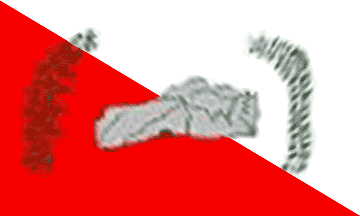 image by Dirk Schönberger,
20 November 2012
image by Dirk Schönberger,
20 November 2012Source: http://pt.wikipedia.org/wiki/Itatinga

Last modified: 2012-12-10 by ian macdonald
Keywords: sao paulo | itatinga |
Links: FOTW homepage |
search |
disclaimer and copyright |
write us |
mirrors
 image by Dirk Schönberger,
20 November 2012
image by Dirk Schönberger,
20 November 2012
Source:
http://pt.wikipedia.org/wiki/Itatinga
Divided per bend, white over red, with a pile of stones in the centre, and two fronds on either side.
Official website at
http://www.pmitatinga.sp.gov.br
Dirk Schönberger,
20 November 2012
Itatinga is named for the Tupi-Guarani words "ita", "a stone", and "tinga", "white", recalling rocks located east of the town. Following the establishment of an early settlement in 1875, the district of São João de Itatinga was established on 1 April 1891. The municipality of São João de Itatinga, seceding from Avaré, was established on 24 July 1896 and inaugurated on 15 May 1898. The name of the municipality was shortened to Itatinga on 30 November 1938.
The flag is made of two triangles, white at the top and red at the bottom, separated by a bend. White represents peace as feature and aspiration of the inhabitants. Red, taken from the municipal coat of arms, represents São Paulo State. In the middle of the flag are three white stones outlined in black, recalling the origin of the name of the municipality, in Tupi-Guarani, "white stones", surrounded on the left by a branch of coffee, once the main source of income of the emerging municipality, and on the right by a branch of eucalyptus, representing the present-day's town. Accordingly, the whole flag represents the past, present and future of Itatinga.
http://pt.wikipedia.org/wiki/Bandeira_de_Itatinga - "Wikipedia",
quoting the description of the the flag from a page of the municipal
website no longer available
Ivan Sache, 24 November 2012